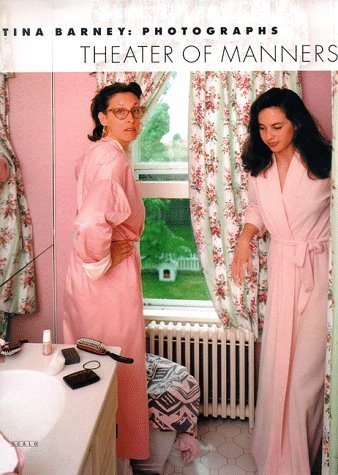Barney, Tina: Tina Barney Photographs, Theater of Manners
Scalo
1997
First Edition
A cursory glance at Tina Barney's first monograph, Theater of Manners, finds a simple set of family snapshots. A closer look, though, reveals that these color photographs, deeply saturated in light and expertly reproduced, are in fact a carefully organized survey into the realm of familial and social relationships. The offhanded quality of the images is not accidental. Barney has a strong eye for the family tableau: children sprawled over the furniture in a formal parlor, shirtless and tan adult brothers tending the barbecue, young cousins in matching double-breasted jackets, Aunt Shirley in a floral dress in the center of a flower-wallpapered room. The reader is never quite sure just how posed the models are--everything seems just a bit too perfect, but then that may be one of the points these photos aim to make. Barney grew up cosseted by a family of upper-middle-class Easterners, and it seems she turns her camera back on that roseate world to discover the strains and strengths that form its foundation. This set of images is organized loosely like a family album; as the pages turn, the reader is carried through the years. Babies become teenagers, girls at the beach become young women in bridesmaids dresses. It becomes readily apparent that Barney is a highly skilled artist and an excellent observer of the complex relationships we all share with those we love.
New York photographer, Tina Barney, was born to a wealthy upper-class New England family, and has turned this pedigree into an artistic study of her world. The viewer witnesses dense moments of emotion-filled social rituals - weddings, Christmas dinners and cocktail parties in rich surroundings - fraught with tensions, frictions and the search for real connections. Pain and loneliness inhabit even the most carefully furnished houses. Barney's painterly tableaux vivants often have several levels of meaning, revealed in her careful compositions. In this monograph, she is revealed as a combination of artist and visual anthropologist.
Scalo
1997
First Edition
A cursory glance at Tina Barney's first monograph, Theater of Manners, finds a simple set of family snapshots. A closer look, though, reveals that these color photographs, deeply saturated in light and expertly reproduced, are in fact a carefully organized survey into the realm of familial and social relationships. The offhanded quality of the images is not accidental. Barney has a strong eye for the family tableau: children sprawled over the furniture in a formal parlor, shirtless and tan adult brothers tending the barbecue, young cousins in matching double-breasted jackets, Aunt Shirley in a floral dress in the center of a flower-wallpapered room. The reader is never quite sure just how posed the models are--everything seems just a bit too perfect, but then that may be one of the points these photos aim to make. Barney grew up cosseted by a family of upper-middle-class Easterners, and it seems she turns her camera back on that roseate world to discover the strains and strengths that form its foundation. This set of images is organized loosely like a family album; as the pages turn, the reader is carried through the years. Babies become teenagers, girls at the beach become young women in bridesmaids dresses. It becomes readily apparent that Barney is a highly skilled artist and an excellent observer of the complex relationships we all share with those we love.
New York photographer, Tina Barney, was born to a wealthy upper-class New England family, and has turned this pedigree into an artistic study of her world. The viewer witnesses dense moments of emotion-filled social rituals - weddings, Christmas dinners and cocktail parties in rich surroundings - fraught with tensions, frictions and the search for real connections. Pain and loneliness inhabit even the most carefully furnished houses. Barney's painterly tableaux vivants often have several levels of meaning, revealed in her careful compositions. In this monograph, she is revealed as a combination of artist and visual anthropologist.
Scalo
1997
First Edition
A cursory glance at Tina Barney's first monograph, Theater of Manners, finds a simple set of family snapshots. A closer look, though, reveals that these color photographs, deeply saturated in light and expertly reproduced, are in fact a carefully organized survey into the realm of familial and social relationships. The offhanded quality of the images is not accidental. Barney has a strong eye for the family tableau: children sprawled over the furniture in a formal parlor, shirtless and tan adult brothers tending the barbecue, young cousins in matching double-breasted jackets, Aunt Shirley in a floral dress in the center of a flower-wallpapered room. The reader is never quite sure just how posed the models are--everything seems just a bit too perfect, but then that may be one of the points these photos aim to make. Barney grew up cosseted by a family of upper-middle-class Easterners, and it seems she turns her camera back on that roseate world to discover the strains and strengths that form its foundation. This set of images is organized loosely like a family album; as the pages turn, the reader is carried through the years. Babies become teenagers, girls at the beach become young women in bridesmaids dresses. It becomes readily apparent that Barney is a highly skilled artist and an excellent observer of the complex relationships we all share with those we love.
New York photographer, Tina Barney, was born to a wealthy upper-class New England family, and has turned this pedigree into an artistic study of her world. The viewer witnesses dense moments of emotion-filled social rituals - weddings, Christmas dinners and cocktail parties in rich surroundings - fraught with tensions, frictions and the search for real connections. Pain and loneliness inhabit even the most carefully furnished houses. Barney's painterly tableaux vivants often have several levels of meaning, revealed in her careful compositions. In this monograph, she is revealed as a combination of artist and visual anthropologist.

